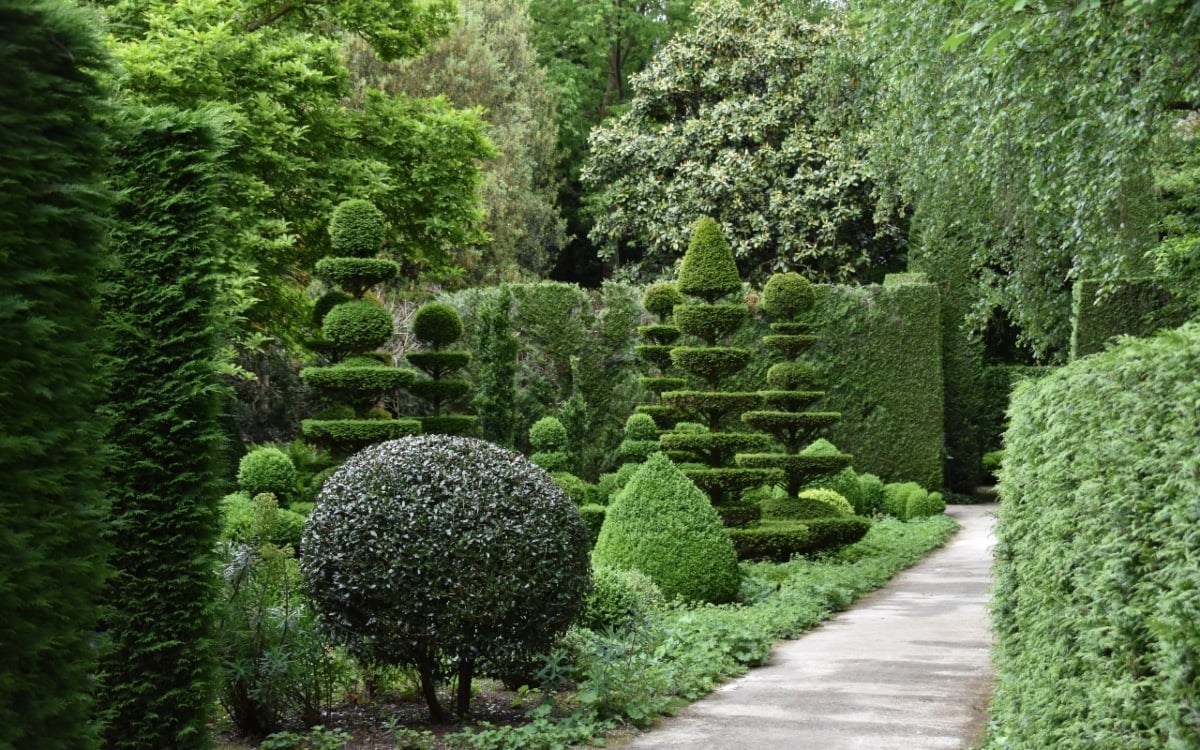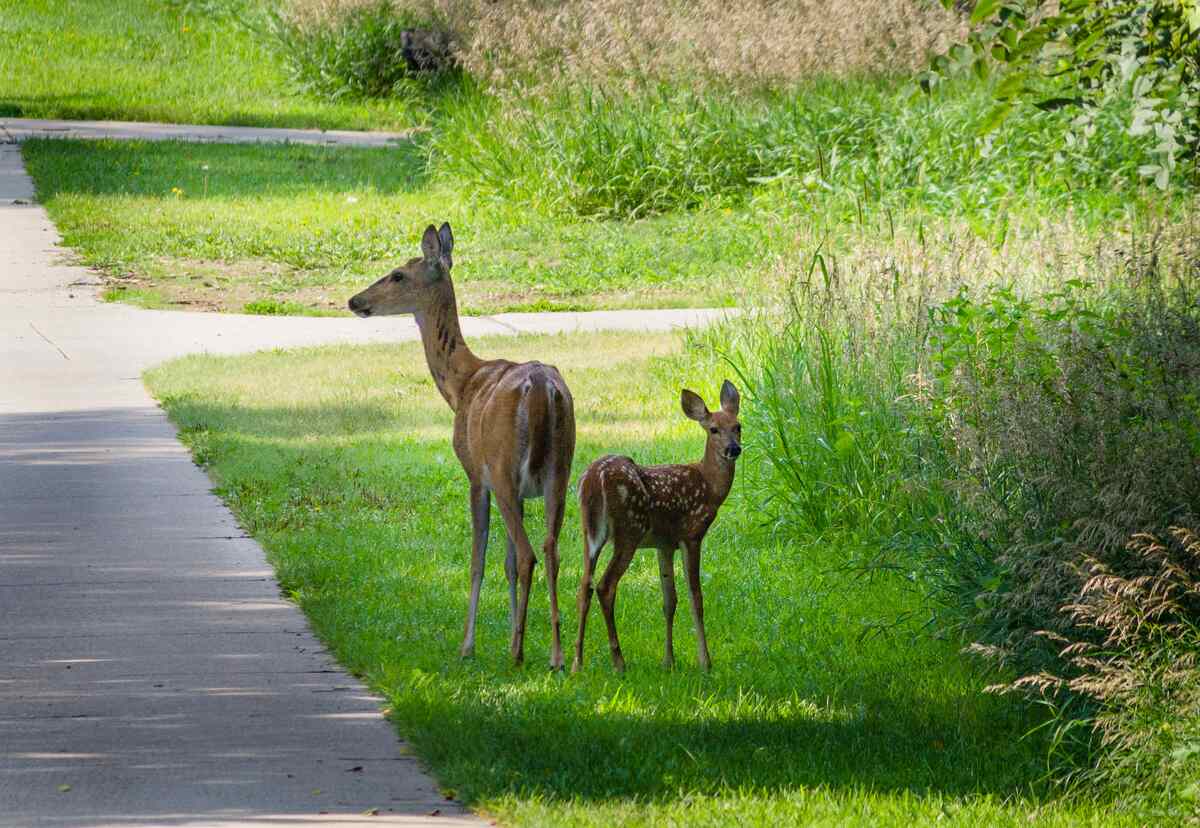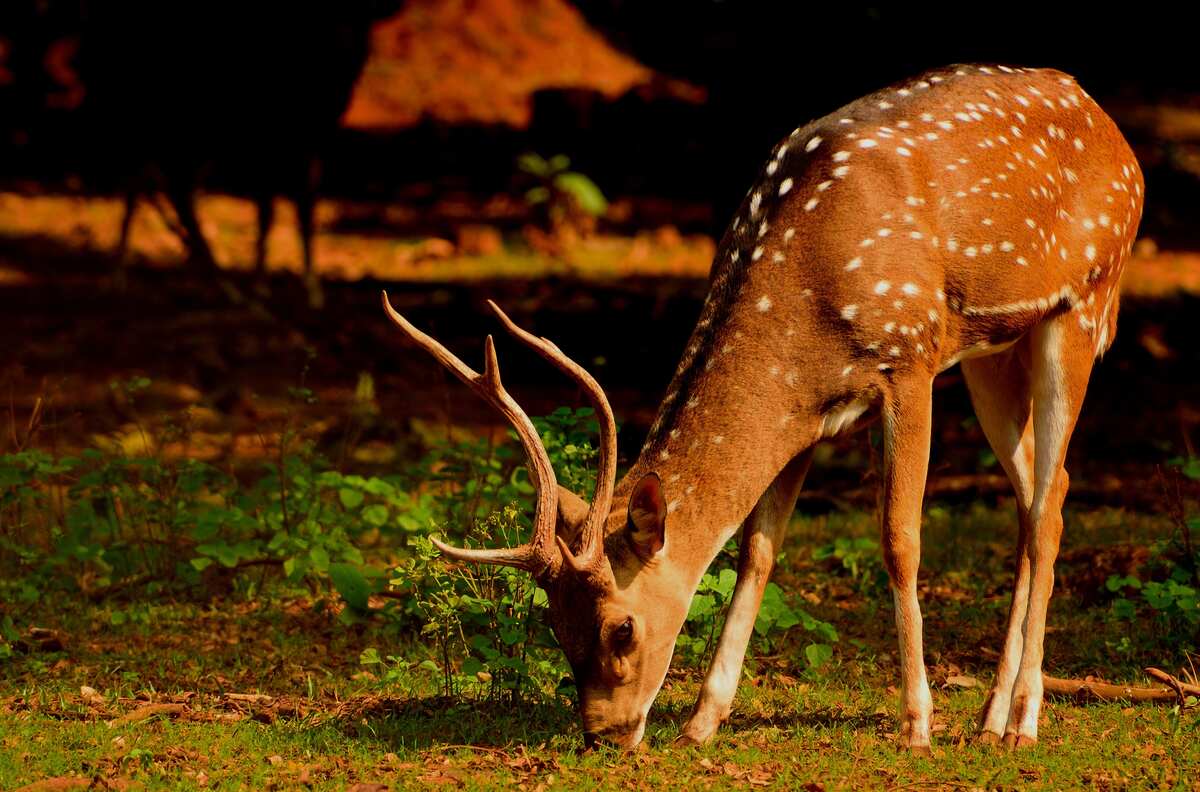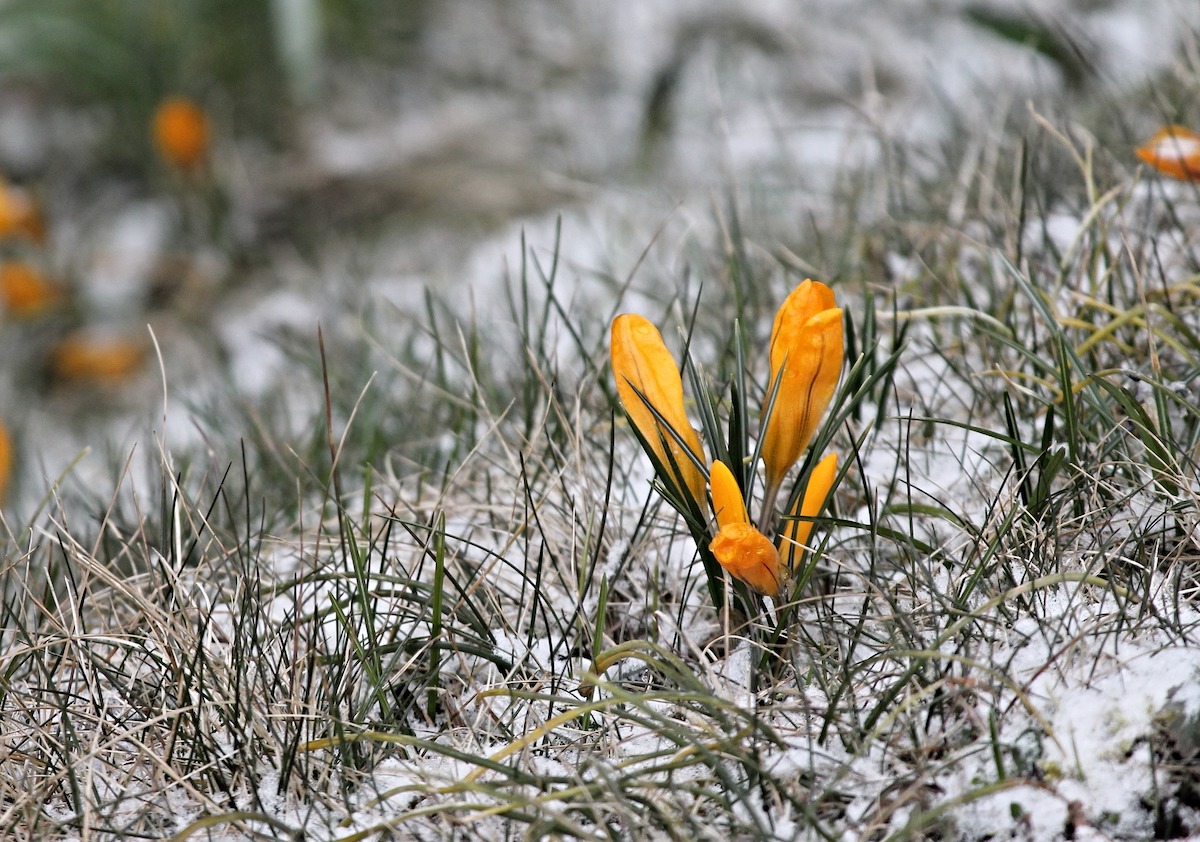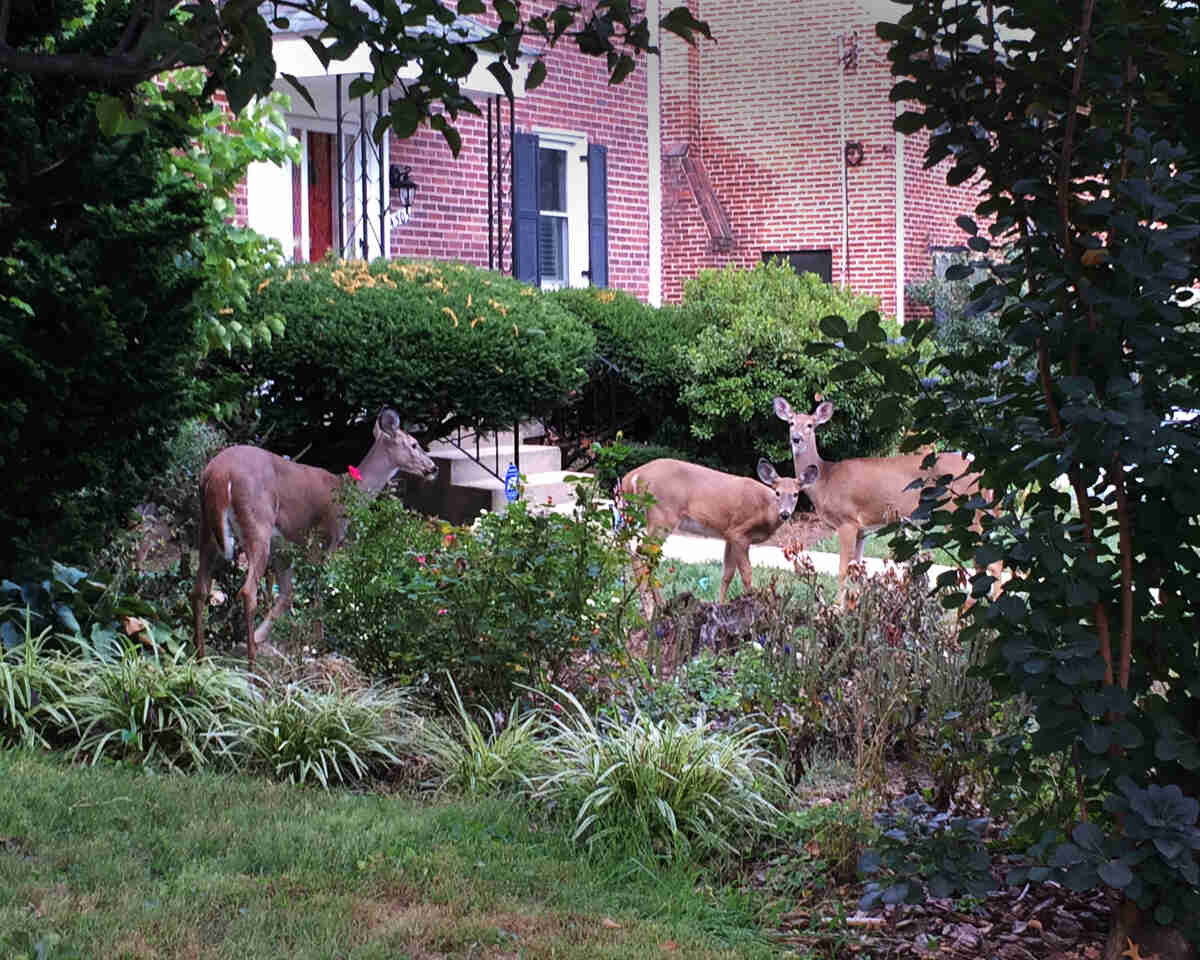
It seems harsh to call deer a nuisance. But should these beautiful animals arrive in your yard when food sources are limited, they can make a meal out of your shrubs and do significant damage to your landscape. However, you can shut down the deer buffet by planting deer-resistant shrubs in your yard.
Many common shrubs are both distasteful to deer and aesthetically pleasing. Depending on where you live, your landscape design, and your lifestyle, there are countless varieties of deer-resistant shrubs to choose from.
- 15 Best Deer-Resistant Shrubs
- 1. Boxwood Shrubs (Buxus)
- 2. Juniper (Juniperus)
- 3. Russian Sage (Salvia yangii)
- 4. Arrowwood Viburnum (Viburnum dentatum)
- 5. Lilac (Syringa vulgaris)
- 6. Dogwood (Cornus alba or Cornus sericea)
- 7. Ninebark (Physocarpus opulifolius)
- 8. Japanese Pieris (Pieris japonica)
- 9. Mountain Laurel (Kalmia latifolia)
- 10. Fragrant Sumac (Rhus aromatica)
- 11. Butterfly Bush (Buddleia or Buddleja)
- 12. Bayberry (Myrica)
- 13. Spirea ‘Goldflame’ (Spirea japonica ‘Goldflame’)
- 14. Barberry ‘Crimson Pygmy’ (Berberis thunbergii var. atropurpurea)
- 15. Hydrangea ‘Oakleaf’ (Hydrangea quercifolia)
- How Deer Damage Yards
- Other Ways to Repel Deer
- FAQ
15 Best Deer-Resistant Shrubs
1. Boxwood Shrubs (Buxus)
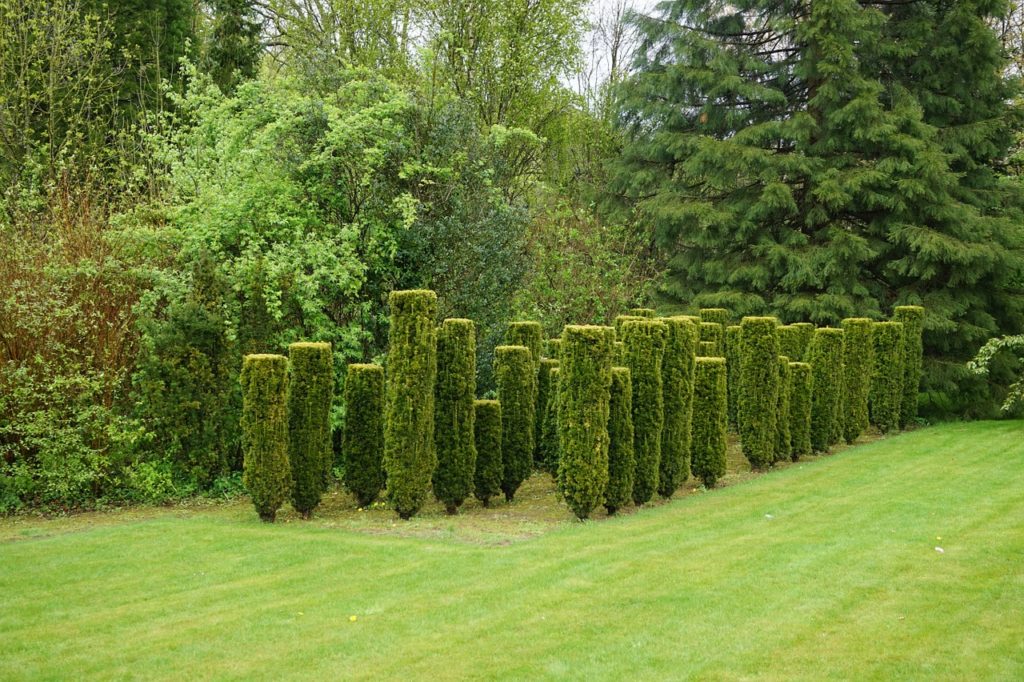
Are you one of those homeowners who wonders, “Do deer eat boxwood?” If so, the answer is no. These popular broadleaf evergreens are deer-resistant due to the bitter taste of their alkaloids.
Since Boxwood shrubs keep their leaves and stay green in the winter, they are ideal for formal hedges, borders, and topiaries. In the spring, Boxwood’s spring-flowering habit brings forth inconspicuous yellow flowers.
- USDA Hardiness Zone: Zones 5 through 9. Some varieties are hardy to Zone 4.
- Color: Foliage ranges from dark green to yellowish green
- Mature height: From 2 to 12 feet, though some can grow as high as 20 feet
- Sun tolerance: They prefer partial shade but can tolerate full sun. Overexposure can burn or bronze the foliage.
- Drought tolerance: Extremely drought-tolerant once established
- Soil type: Boxwoods will adapt to various types of soil but prefer loamy, evenly moist, well-draining soil. The ideal soil pH is 6.5 to 7.
2. Juniper (Juniperus)
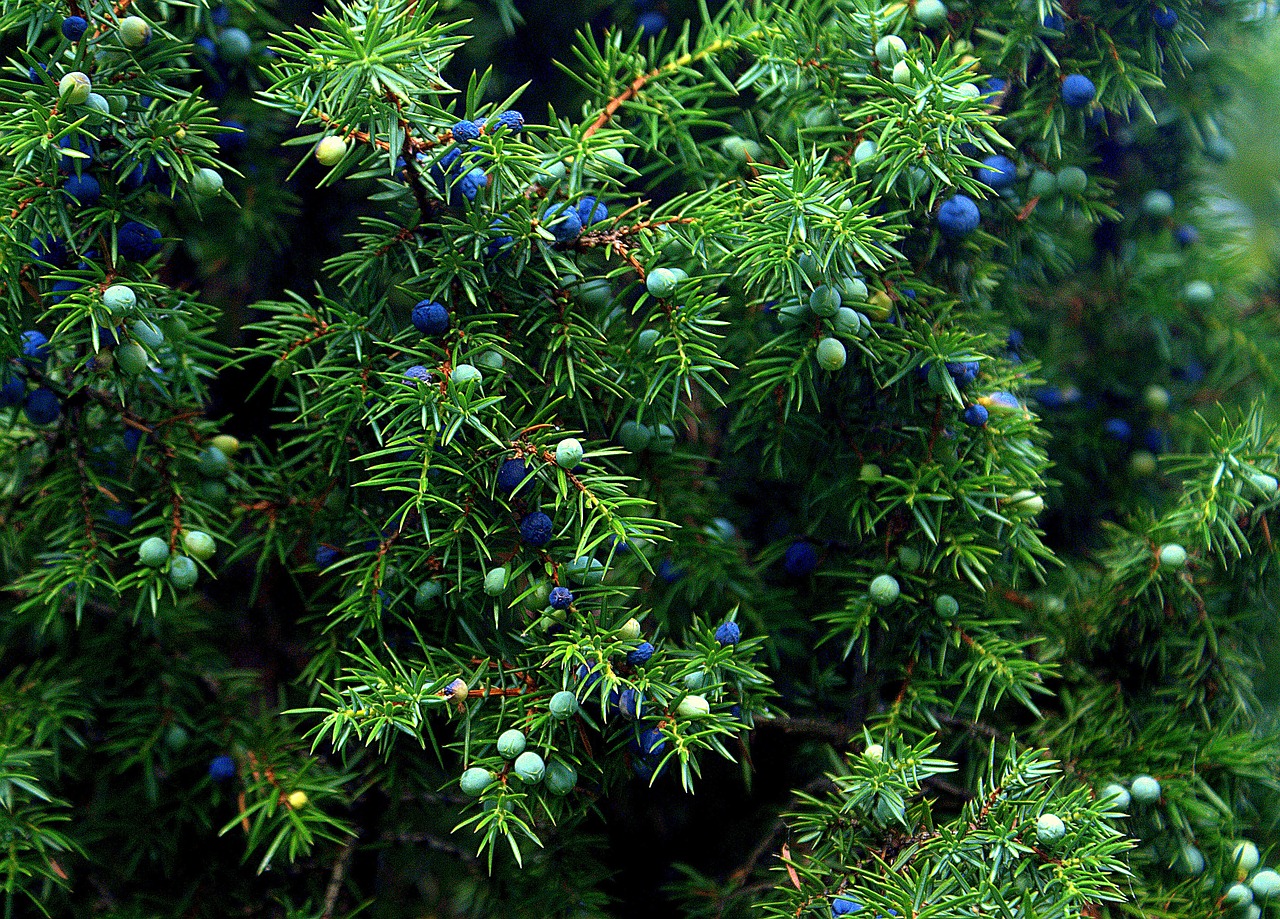
These deer-resistant evergreen shrubs are extremely versatile. With more than 170 varieties, juniper serves as ground cover, accent plantings, topiaries, and privacy screens. This low-maintenance plant repels deer through the oils in its needles and its prickly texture.
Junipers are male or female. Females produce small yellow flowers followed by berries. Depending on the variety, female junipers are pollinated from December to February or November to April. Note that juniper pollen can cause allergy symptoms in people, so take care where you plant them.
- USDA Hardiness Zone: Zones 3 to 9, depending on the variety
- Color: Blue, green, yellow, gray, or silver, depending on variety
- Mature height: Depending on the species, junipers can grow from 4 inches to 50 feet tall.
- Sun tolerance: Prefers full sun but can handle light shade
- Drought tolerance: High, once established
- Soil type: Juniper tolerates a wide range of soils, including clay, but prefers a well-drained sandy clay or loam. Juniper grows best in moderately acidic to slightly alkaline soil, between 6.0 to 7.5 pH.
3. Russian Sage (Salvia yangii)

Technically a subshrub, Russian sage is a low-maintenance, deer-resistant perennial that produces small, bluish-lavender flowers throughout the summer.
Russian sage has fragrant foliage that attracts hummingbirds, honey bees, and butterflies but repels deer. This shrub also flourishes in dry conditions, making it a go-to option for xeriscaping.
- USDA Hardiness Zone: Zones 4 to 9.
- Color: Silver-green stems with blue-purple flowers in the summer.
- Mature height: From 2 to 4 feet, depending on the variety
- Sun tolerance: Prefers full sun
- Drought tolerance: Once established, it needs little water.
- Soil type: These shrubs thrive in well-drained soil but can also tolerate clay. Russian sage prefers alkaline soils of pH 7 and greater.
4. Arrowwood Viburnum (Viburnum dentatum)

In the category of deer-resistant flowering shrubs, arrowwood viburnum is worth mentioning. It bears beautiful red foliage, blue and red berries in the fall, and white flowers in May and June. Arrowwood viburnum is generally low-maintenance, and its fragrance and texture are unappetizing to deer.
- USDA Hardiness Zone: Zones 2 to 8
- Color: White flowers, dark green foliage, and bluish berries
- Mature height: 3 to 10 feet
- Sun tolerance: Likes full sun, but will tolerate part shade
- Drought tolerance: Low. The shrub needs moist soil.
- Soil type: Not only is arrowwood viburnum deer-resistant, but it also grows well in a variety of soil conditions with proper drainage. It can tolerate soil that’s acidic, alkaline, loamy, moist, rich, sandy, silty and loamy, and clay.
5. Lilac (Syringa vulgaris)

Deer avoid lilac bushes because of their strong aroma. The white, purple, and Persian fragrant flowers start to bloom in early spring. The shrub resists deer but not pollinators. Butterflies and bees will flock to your yard. Lilac is easy to grow from cuttings, or you can buy young shrubs at your garden center.
- USDA Hardiness Zone: Zones 2 to 7
- Color: White, pink, or purple flowers, dark green foliage
- Mature height: Smaller varieties grow 2 to 3 feet high. Some reach 12 feet or more.
- Sun tolerance: A lilac needs full sun if you want it to flower.
- Drought tolerance: Low. Lilac needs moist, well-draining soil. But too much water will stunt its growth.
- Soil type: Lilacs thrive in fertile, humus-rich, well-drained, neutral to alkaline soil. They need a pH near 7.0.
6. Dogwood (Cornus alba or Cornus sericea)
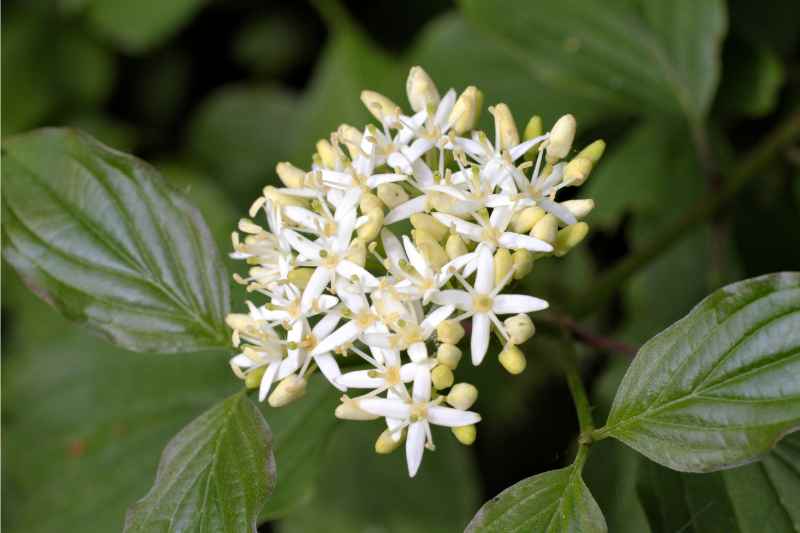
These fast-growing woody plants come in several varieties, including a ground cover named Canadian bunchberry. Dogwood is toxic to humans and distasteful to deer. They ignore the fruit, fragrant flowers, and the bright red twigs in the winter. Choose from Cornus alba or Cornus sericea for bright red winter twigs and deer resistance.
Note: The most common dogwood is the flowering dogwood (Cornus florida), which goes dormant in the winter and blooms again in early spring. However, the flowering dogwood is a tree, not a shrub.
- USDA Hardiness Zone: Zones 2 or 3 to 7
- Color: White or yellowish-white flowers in spring, white berries in summer, and red twigs in winter
- Mature height: Can range from 5-10 feet tall, depending on variety and environmental conditions
- Sun tolerance: Full sun to partial shade
- Drought tolerance: Low; prefers moist soil with good drainage
- Soil type: Cornus alba prefers acidic to neutral soil with a pH ranging from below 6 to 8. Cornus sericea prefers neutral to alkaline soils.
7. Ninebark (Physocarpus opulifolius)
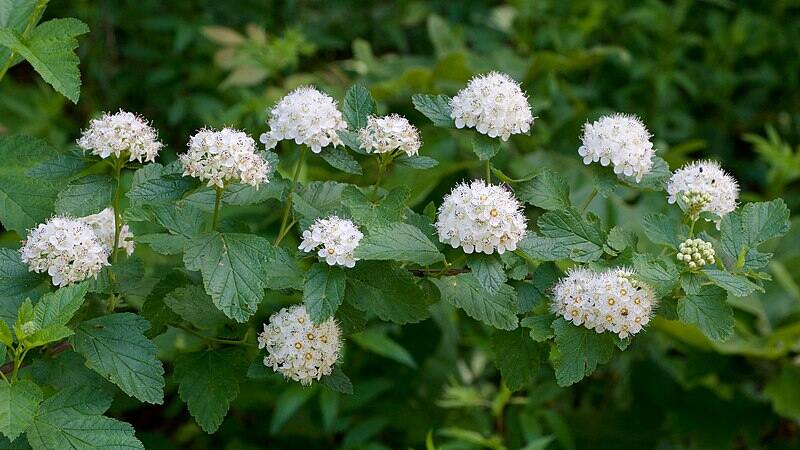
A member of the rose family, ninebark is perfect for those looking for fast-growing deer-resistant shrubs. It produces beautiful blooms during late spring and early summer. Ninebark is adaptable to most conditions and can be used as a hedge or shrub border, or for erosion control.
- USDA Hardiness Zone: Zones 2 to 8
- Color: Usually frothy white flowers; dark green leaves that turn yellow to red in the fall
- Mature height: 3 to 8 feet
- Sun tolerance: Does best with full sun, but tolerates partial shade
- Drought tolerance: This deciduous shrub prefers well-drained soil but tolerates drought and occasionally wet soil conditions.
- Soil type: Ninebark prefers acidic, loamy soil but tolerates alkaline and clay soils.
8. Japanese Pieris (Pieris japonica)
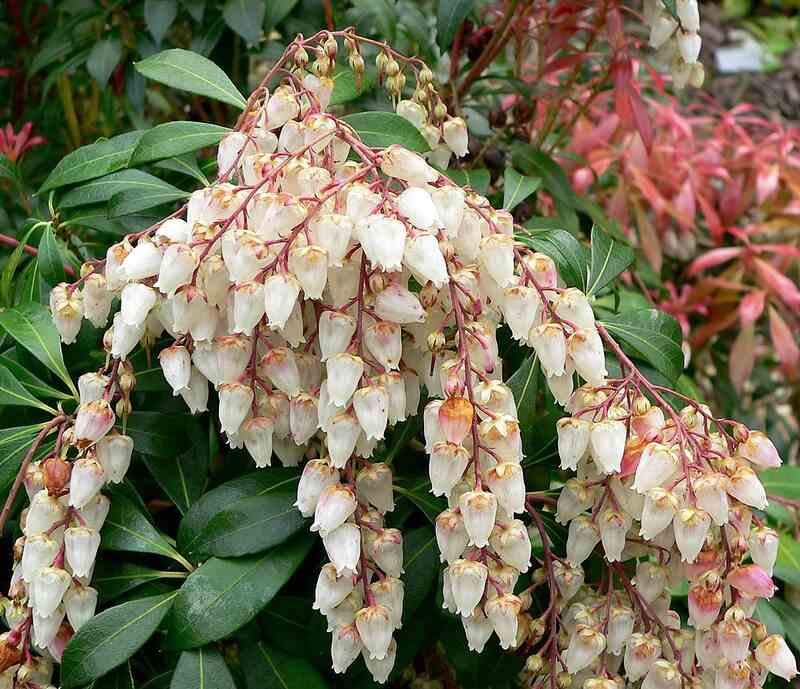
Japanese pieris, sometimes known as Andromeda, is an evergreen shrub that deer tend to pass by. In early spring, it produces drooping clusters of white flowers that attract pollinators. Note: The leaves and nectar of Japanese pieris are highly toxic, so use caution if you have young children and pets.
- USDA Hardiness Zone: Zones 4 to 8
- Color: Glossy green leaves; new leaves are purple to bronze-red
- Mature height: 9 to 13 feet tall
- Sun tolerance: Full sun to partial shade
- Drought tolerance: Low. This shrub prefers moist soils.
- Soil type: Japanese pieris prefers well-drained, acidic soil.
9. Mountain Laurel (Kalmia latifolia)
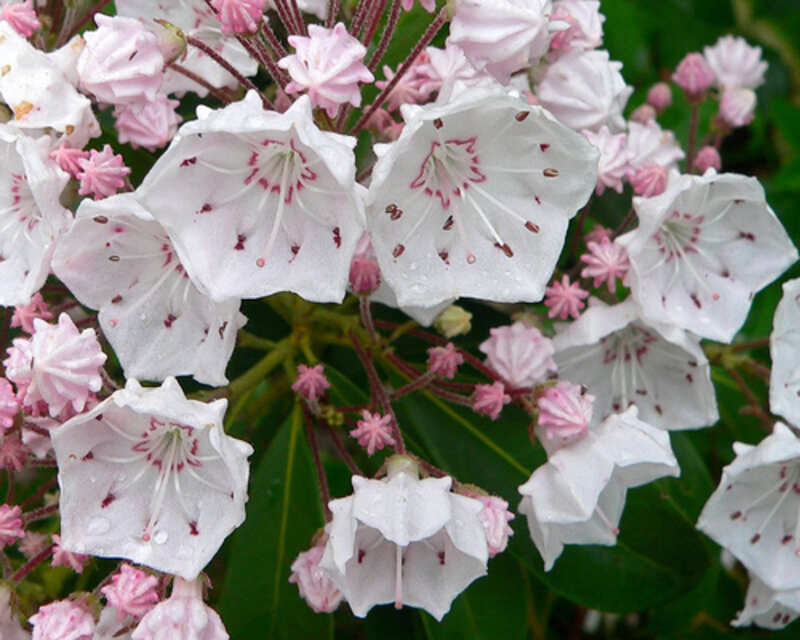
This evergreen has been cultivated since the 18th century and produces the state flower of Pennsylvania. During May and June, mountain laurel produces flowers that resemble inverted parasols. Deer usually ignore it because it contains glycosides, which burn the mouth if eaten.
- USDA Hardiness Zone: Zones 4 to 9
- Color: Dark green leaves; white to blush pink flowers
- Mature height: Grows in large mounds that average 7 to 10 feet but can reach up to 20 feet
- Sun tolerance: Flowers best in light shade
- Drought tolerance: Low
- Soil type: Prefers moist, well-drained, acidic soil
10. Fragrant Sumac (Rhus aromatica)
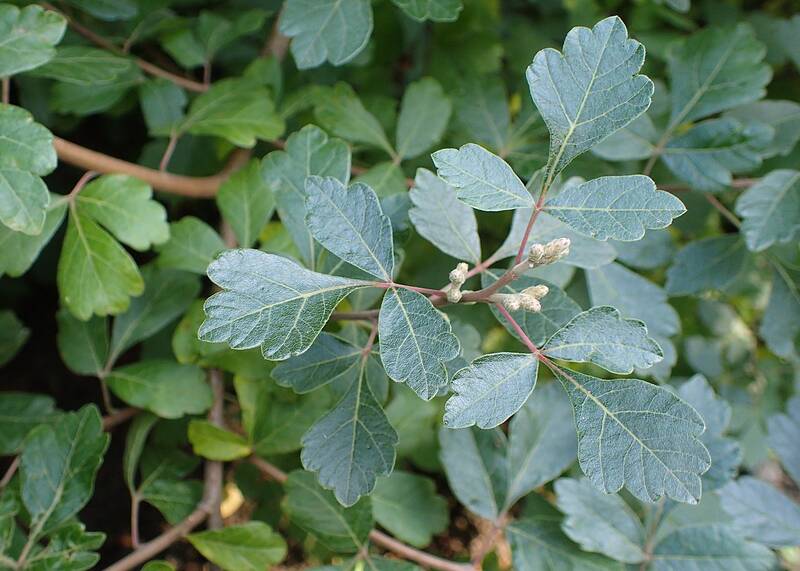
As its name suggests, this deciduous shrub produces a strong odor that deer (and some humans) don’t like. Before the foliage appears in early spring, the shrub produces small yellow flowers; hairy red berries arrive in the fall. Fragrant sumac spreads aggressively and is used as ground cover or to stabilize embankments.
- USDA Hardiness Zone: Zones 3 to 9
- Color: Dark green leaves that become orange, red, or reddish-purple in fall
- Mature height: Usually under 2 feet tall
- Sun tolerance: Full sun to partial shade
- Drought tolerance: High. It grows best in dry, well-drained soils.
- Soil type: Fragrant sumac prefers acidic soil but can tolerate just about anything if it’s well drained.
11. Butterfly Bush (Buddleia or Buddleja)
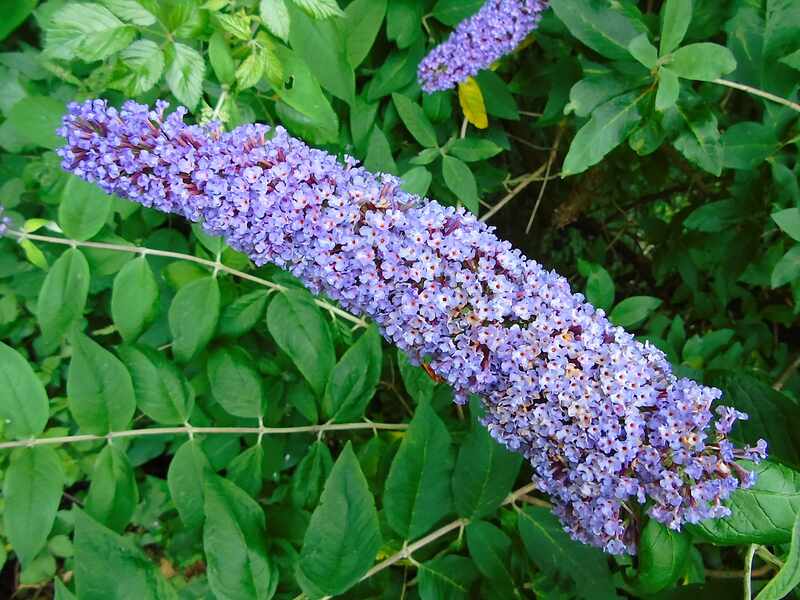
Also known as Buddleia, this shrub attracts butterflies and other beneficial insects. But deer dislike the strong, sweet scent. From June to October, it produces clusters of purple, pink, white, lavender, yellow, or multicolored blooms.
Note: In some areas of the country, butterfly bush is considered an invasive plant. Check with your county Extension service for details.
- USDA Hardiness Zone: Zones 5 to 9
- Color: Leaves may be deep green, gray-green, or silver-gray depending on the variety
- Mature height: 6-10 feet tall
- Sun tolerance: Full sun to ensure flowering
- Drought tolerance: Fairly drought tolerant once established
- Soil type: Butterfly bush prefers acidic soil (pH of 6.0 to 7.0), but it can handle a wide variety of soils if they are well-drained.
12. Bayberry (Myrica)
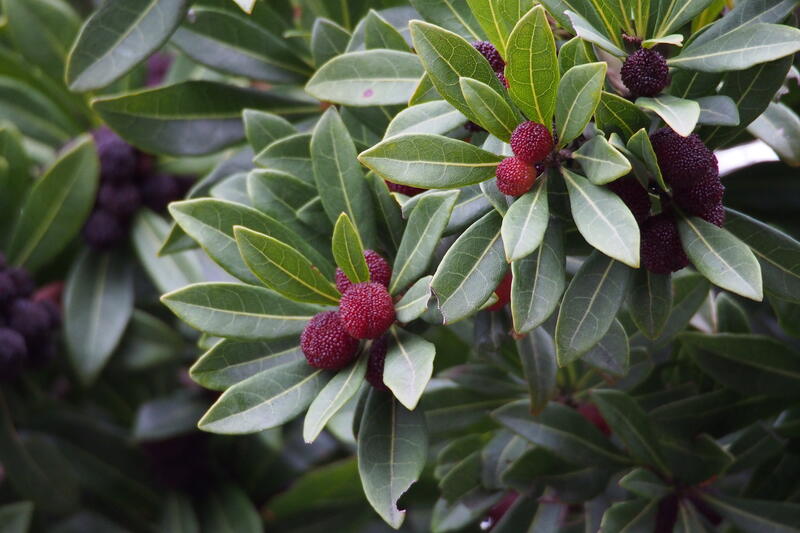
This perennial shrub has a strong fragrance that deer dislike. It can be used along borders or as a privacy screen. Bayberry has male and female plants. Both bloom from April to early June. Male plants produce small yellow-green flowers. Females produce bluish-gray berries used in candles, soaps, and other aromatic products.
- USDA Hardiness Zone: Zones 3 to 7
- Color: Dark green, glossy leaves
- Mature height: Usually 6-8 feet, though it can reach 15 feet
- Sun tolerance: Full to partial sun
- Drought tolerance: Moderately tolerant
- Soil type: Bayberry prefers well-drained, slightly acidic, sandy soils.
13. Spirea ‘Goldflame’ (Spirea japonica ‘Goldflame’)
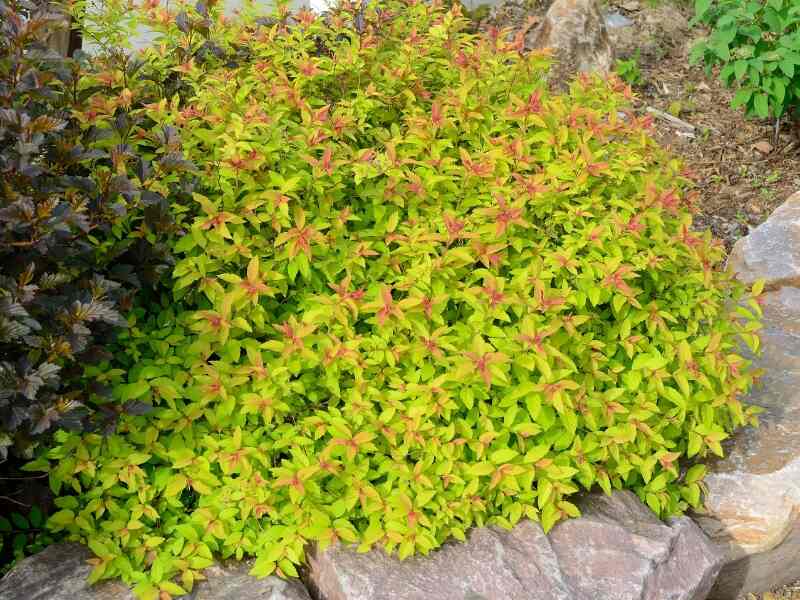
Goldflame is a tough, adaptable cultivar of Spirea that withstands harsh conditions like poor soil and drought once established. So, if you’re in the market for deer-resistant flowering bushes, you’re in luck — Spirea is a great choice.
Clusters of deep pink flowers bloom between June and July. The plant’s green leaves start out as red, copper, and yellow before turning red-purple in the fall.
- USDA Hardiness Zone: Zones 4 to 8
- Color: Green leaves
- Mature height: 2-3 feet tall
- Sun tolerance: Full sun to partial shade
- Drought tolerance: Fairly drought tolerant once established
- Soil type: Acidic, neutral
14. Barberry ‘Crimson Pygmy’ (Berberis thunbergii var. atropurpurea)
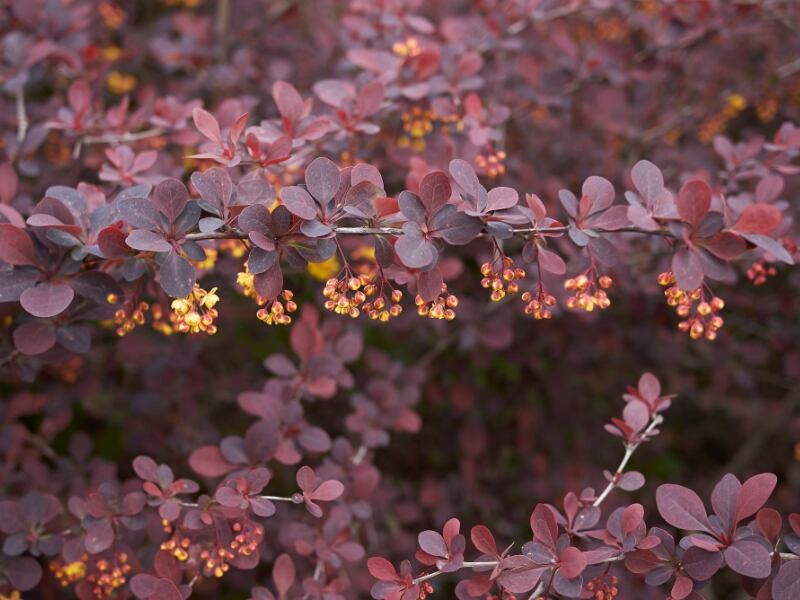
The Crimson Pygmy barberry is a hardy shrub that can be used as an accent plant or low hedge. It can tolerate dry soils and requires minimal maintenance. Its leaves turn from red to purple and stay colorful throughout the summer and fall.
It is best grown in full sun to enhance its color. In the fall, it produces bright red berries that make for a beautiful display that lasts throughout the winter.
- USDA Hardiness Zone: Zones 4 to 8
- Color: Crimson purple
- Mature height: 2-3 feet
- Sun tolerance: Full sun
- Drought tolerance: Fairly drought tolerant once established. Avoid wet sites.
- Soil type: Well-drained sand or clay soil with an alkaline pH
15. Hydrangea ‘Oakleaf’ (Hydrangea quercifolia)
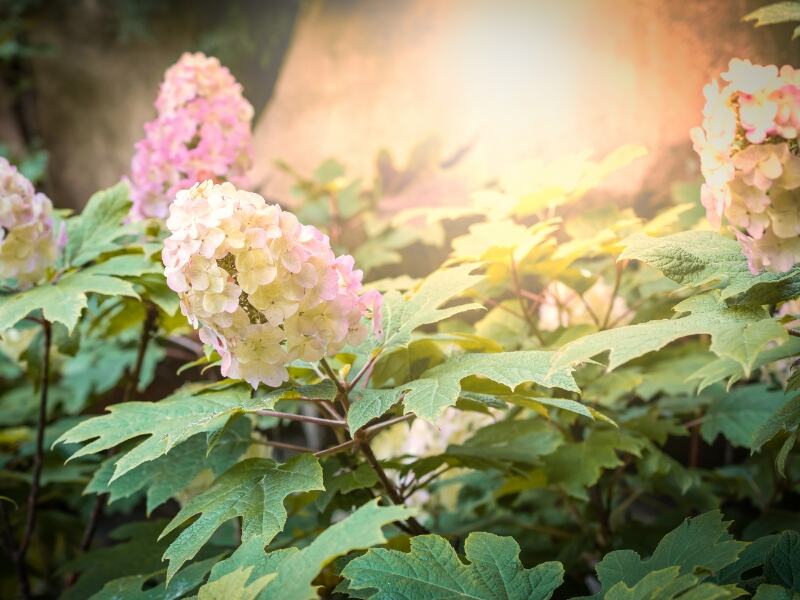
The Oakleaf hydrangea is a deciduous shrub that grows upright with multiple stems. It thrives in areas with moist woods and stream banks. It can grow up to 8 feet tall and 6 to 8 feet wide. This shrub has pyramidal clusters of white blooms and sizeable dark green leaves that look almost the same as an oak tree.
- USDA Hardiness Zone: Zones 5 to 9
- Color: Deep green leaves
- Mature height: 4-8 feet high
- Sun tolerance: Full sun, partial shade
- Drought tolerance: Drought tolerant once established
- Soil type: Slightly acidic soil
How Deer Damage Yards
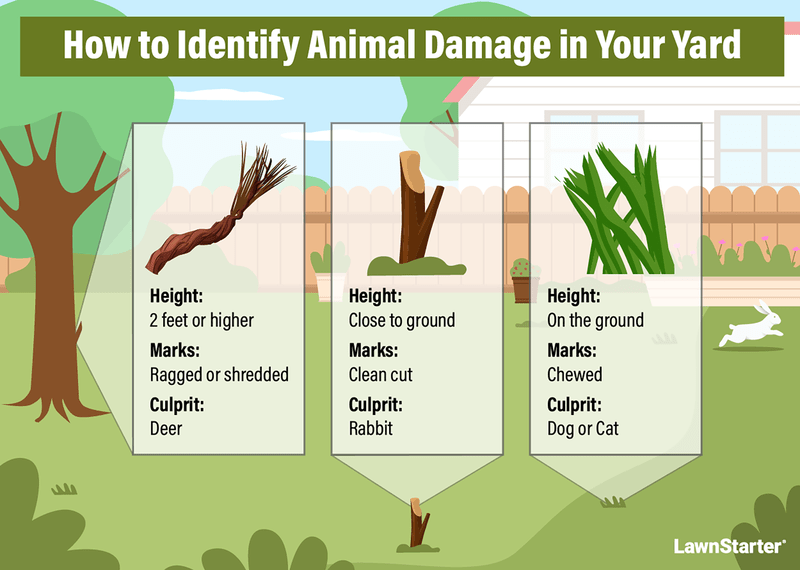
So, at this point, you may be wondering why you should go to the expense and effort of planting deer-resistant shrubs. The best reason: To protect all of your yard. Once deer are finished munching on (or uprooting) your shrubs, they can cause other problems:
- Tree Damage. Like with shrubs, deer can chow down on young branches. Or they strip the bark from branches and trunks. (Note: Deer don’t have upper incisors, so they shred bark and twigs.) During mating season, bucks rub their antlers against the bark, which can kill younger trees.
- Disease risks. Deer droppings are known to contain E. coli, Listeria, and Cryptosporidium, which could possibly contaminate any fruits or vegetables in your garden.
- Tick-disease risks. While deer generally aren’t infected by tick-borne diseases, like Lyme disease, they can carry ticks into wooded or brushy areas of your property.
Other Ways to Repel Deer
Planting deer-resistant shrubs will help keep the deer population at bay. But hungry deer can be tenacious: You may have to take other steps to make your yard more deer-proof, such as planting deer-resistant plants and using additional tactics to keep deer out of your yard.
Plant Deer-Resistant Plants
Deer-resistant ground cover:
- Aromatic aster
- Mondo grass
- Bloody cranesbill
Deer-resistant perennials:
- Catmint
- Daffodils
- Lantana
Deer-resistant annuals:
- Canna lilies (late summer bloomer)
- Sweet alyssum
- Marigolds
Deer-resistant trees:
- Chastetree
- Crape myrtle
- Ginkgo
Plant strong, aromatic herbs throughout your garden:
- Lavender
- Mint
- Thyme
- Chives
- Rosemary
Deer dislike plants with strong fragrances.
Other Tactics to Repel Deer
Other ways you can deter deer include:
- Hang wind chimes or install a motion-activated sprinkler. Deer are scared of loud noises and sudden movement.
- Try deer repellent. Some commercial varieties are available. Or you can try more unusual methods, like hanging Irish Spring soap, sprinkling chili powder, or dropping human hair, or cat and dog fur in the areas you want Bambi to avoid.
- Build a tall fence. Just make sure it’s at least 8 feet high. Deer can jump. Electric fences can be effective, but they are illegal in some areas. Other areas have ordinances concerning placement. So, be sure to check before you commit.
- Wrap your shrubs. In winter, buy tree wrap made from polypropylene fabric, crinkled paper, or corrugated cardboard to protect plants from deer browsing.
Note: If you decide to install a deer fence, many homeowners in the Northeast prefer using 2×4 wooden posts along with flexible plastic black or green deer fencing that comes in rolls. They usually place the 2×4 posts 6 feet apart and attach the fencing firmly onto the posts.
This system is ideal as it easily blends in with the surrounding landscape, particularly if you live in a wooded area. It’s advisable to have it at a minimum height of 6 feet since the deer can stand on their hind legs when trying to access something.
FAQ
What’s a Good DIY Deer Repellant Spray?
The University of Minnesota Extension suggests this one:
● Blend three eggs in water, then add enough water to create a gallon of liquid.
● Strain the mix.
● Spray plants until the leaves are wet. Repeat every two weeks.
Can My Shrubs Survive Damage From Deer?
Yes, as long as the shrubs are healthy, there’s a good chance they will survive deer damage. To help shrubs repair injured stems, prune them down to an area of healthy growth.
What Should I Plant to Attract Deer?
The following are good choices if you plan to set up a feeding zone to divert deer:
● Arborvitae
● Wild plum
● Clover
● Prairie crabapple
● Hostas
If you have a wooded area, a felled tree will provide buds and twigs during colder months, and new shoots in the spring.
When to Call a Professional
If you need deer-resistant shrubs, there are many options available to suit your landscape. But if you find it difficult to find just the right fast-growing shrub or the best evergreen, consider calling a professional landscaping service. A local pro can find and maintain the best deer-resistant shrubs for your yard and lifestyle.
Main Photo Credit: woodleywonderworks / Flickr / CC BY 2.0
